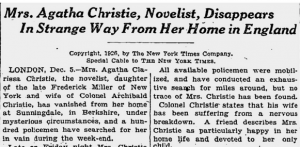Tina Jordan from The New York Times investigates that time when the world’s most famous mystery writer vanished… and didn’t return home for 11 days.
It was like a plot from one of her own novels: On the evening of Dec. 4, Agatha Christie, carrying nothing but an attaché case, kissed her daughter good night and sped away from the home in England that she shared with her husband, Col. Archibald Christie. (He was having an affair with a younger woman; the public did not know this, but his wife definitely did.) No one knew where Christie was for almost two weeks.
Dec. 6, 1926
Christie was 36 at the time and had already published several detective novels, including “The Secret Adversary” and “The Murder on the Links.” Her disappearance merited banner headlines the world over, making the front page of The Times on Dec. 6.
“The novelist’s car was found abandoned near Guildford on the edge of a chalk pit, the front wheels actually overhanging the edge,” the paper reported. “The car evidently had run away, and only a thick hedge-growth prevented it from plunging into the pit.”
Dec. 8, 1926
After three days of searching for the novelist, the police called it off. They said Christie’s brother-in-law had received a letter from her, saying she was going to a Yorkshire spa “for rest and treatment.” Case closed, right? Not quite.
Dec. 10, 1926
The police, apparently unconvinced by the letter, expanded their search, even bringing one of Christie’s pets to the scene to see if he could track his owner’s scent. (The dog just “whined pitifully.”)
Detectives “are now said to be of the opinion that it is a case of suicide,” The Times reported. The search seemed to center on a pond called “the Silent Pool,” which, according to local legend, was bottomless.
There was an especially tantalizing detail near the end of the story: Christie, the paper claimed, had been spooked by her own house. “It stands in a lonely lane, unlit at night, which has a reputation of being haunted. The lane has been the scene of a murder of a woman and the suicide of a man. … ‘If I do not leave Sunningdale soon, Sunningdale will be the end of me,’ she once said to a friend.”
Dec. 11, 1926
A week after Christie’s disappearance, the police were flummoxed. “No reliable witness has seen her since the night she left her house in Sunningdale a week ago,” The Times reported.
But there was one important development. Christie had left three letters behind: one to her secretary, another to her brother-in-law and a third to her husband, who refused to divulge what she had written.
Dec. 12, 1926
Detectives appealed for help from motorists and amateur sleuths: “Without telling why, the police still believe she is somewhere on the downs … not far from the spot where her missing automobile was found.”
In the same article, her personal secretary angrily denied that the whole thing was a publicity stunt: “It is ridiculous. Mrs. Christie is quite too much a lady for that.” The secretary also handed over the note Christie had left for her, saying it contained only scheduling details.
Read full post on The New York Times

